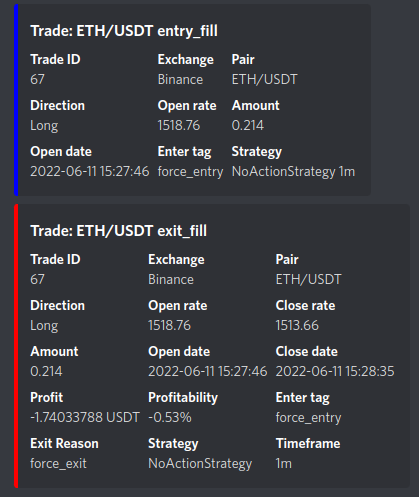9.4 KiB
Webhook usage
Configuration
Enable webhooks by adding a webhook-section to your configuration file, and setting webhook.enabled to true.
Sample configuration (tested using IFTTT).
"webhook": {
"enabled": true,
"url": "https://maker.ifttt.com/trigger/<YOUREVENT>/with/key/<YOURKEY>/",
"entry": {
"value1": "Buying {pair}",
"value2": "limit {limit:8f}",
"value3": "{stake_amount:8f} {stake_currency}"
},
"entry_cancel": {
"value1": "Cancelling Open Buy Order for {pair}",
"value2": "limit {limit:8f}",
"value3": "{stake_amount:8f} {stake_currency}"
},
"entry_fill": {
"value1": "Buy Order for {pair} filled",
"value2": "at {open_rate:8f}",
"value3": ""
},
"exit": {
"value1": "Exiting {pair}",
"value2": "limit {limit:8f}",
"value3": "profit: {profit_amount:8f} {stake_currency} ({profit_ratio})"
},
"exit_cancel": {
"value1": "Cancelling Open Exit Order for {pair}",
"value2": "limit {limit:8f}",
"value3": "profit: {profit_amount:8f} {stake_currency} ({profit_ratio})"
},
"exit_fill": {
"value1": "Exit Order for {pair} filled",
"value2": "at {close_rate:8f}.",
"value3": ""
},
"status": {
"value1": "Status: {status}",
"value2": "",
"value3": ""
}
},
The url in webhook.url should point to the correct url for your webhook. If you're using IFTTT (as shown in the sample above) please insert your event and key to the url.
You can set the POST body format to Form-Encoded (default), JSON-Encoded, or raw data. Use "format": "form", "format": "json", or "format": "raw" respectively. Example configuration for Mattermost Cloud integration:
"webhook": {
"enabled": true,
"url": "https://<YOURSUBDOMAIN>.cloud.mattermost.com/hooks/<YOURHOOK>",
"format": "json",
"status": {
"text": "Status: {status}"
}
},
The result would be a POST request with e.g. {"text":"Status: running"} body and Content-Type: application/json header which results Status: running message in the Mattermost channel.
When using the Form-Encoded or JSON-Encoded configuration you can configure any number of payload values, and both the key and value will be ouput in the POST request. However, when using the raw data format you can only configure one value and it must be named "data". In this instance the data key will not be output in the POST request, only the value. For example:
"webhook": {
"enabled": true,
"url": "https://<YOURHOOKURL>",
"format": "raw",
"webhookstatus": {
"data": "Status: {status}"
}
},
The result would be a POST request with e.g. Status: running body and Content-Type: text/plain header.
Additional configurations
The webhook.retries parameter can be set for the maximum number of retries the webhook request should attempt if it is unsuccessful (i.e. HTTP response status is not 200). By default this is set to 0 which is disabled. An additional webhook.retry_delay parameter can be set to specify the time in seconds between retry attempts. By default this is set to 0.1 (i.e. 100ms). Note that increasing the number of retries or retry delay may slow down the trader if there are connectivity issues with the webhook.
You can also specify webhook.timeout - which defines how long the bot will wait until it assumes the other host as unresponsive (defaults to 10s).
Example configuration for retries:
"webhook": {
"enabled": true,
"url": "https://<YOURHOOKURL>",
"timeout": 10,
"retries": 3,
"retry_delay": 0.2,
"status": {
"status": "Status: {status}"
}
},
Custom messages can be sent to Webhook endpoints via the self.dp.send_msg() function from within the strategy. To enable this, set the allow_custom_messages option to true:
"webhook": {
"enabled": true,
"url": "https://<YOURHOOKURL>",
"allow_custom_messages": true,
"strategy_msg": {
"status": "StrategyMessage: {msg}"
}
},
Different payloads can be configured for different events. Not all fields are necessary, but you should configure at least one of the dicts, otherwise the webhook will never be called.
Webhook Message types
Entry
The fields in webhook.entry are filled when the bot executes a long/short. Parameters are filled using string.format.
Possible parameters are:
trade_idexchangepairdirectionleveragelimit# Deprecated - should no longer be used.open_rateamountopen_datestake_amountstake_currencybase_currencyquote_currencyfiat_currencyorder_typecurrent_rateenter_tag
Entry cancel
The fields in webhook.entry_cancel are filled when the bot cancels a long/short order. Parameters are filled using string.format.
Possible parameters are:
trade_idexchangepairdirectionleveragelimitamountopen_datestake_amountstake_currencybase_currencyquote_currencyfiat_currencyorder_typecurrent_rateenter_tag
Entry fill
The fields in webhook.entry_fill are filled when the bot filled a long/short order. Parameters are filled using string.format.
Possible parameters are:
trade_idexchangepairdirectionleverageopen_rateamountopen_datestake_amountstake_currencybase_currencyquote_currencyfiat_currencyorder_typecurrent_rateenter_tag
Exit
The fields in webhook.exit are filled when the bot exits a trade. Parameters are filled using string.format.
Possible parameters are:
trade_idexchangepairdirectionleveragegainlimitamountopen_rateprofit_amountprofit_ratiostake_currencybase_currencyquote_currencyfiat_currencyexit_reasonorder_typeopen_dateclose_date
Exit fill
The fields in webhook.exit_fill are filled when the bot fills a exit order (closes a Trade). Parameters are filled using string.format.
Possible parameters are:
trade_idexchangepairdirectionleveragegainclose_rateamountopen_ratecurrent_rateprofit_amountprofit_ratiostake_currencybase_currencyquote_currencyfiat_currencyexit_reasonorder_typeopen_dateclose_date
Exit cancel
The fields in webhook.exit_cancel are filled when the bot cancels a exit order. Parameters are filled using string.format.
Possible parameters are:
trade_idexchangepairdirectionleveragegainlimitamountopen_ratecurrent_rateprofit_amountprofit_ratiostake_currencybase_currencyquote_currencyfiat_currencyexit_reasonorder_typeopen_dateclose_date
Status
The fields in webhook.status are used for regular status messages (Started / Stopped / ...). Parameters are filled using string.format.
The only possible value here is {status}.
Discord
A special form of webhooks is available for discord. You can configure this as follows:
"discord": {
"enabled": true,
"webhook_url": "https://discord.com/api/webhooks/<Your webhook URL ...>",
"exit_fill": [
{"Trade ID": "{trade_id}"},
{"Exchange": "{exchange}"},
{"Pair": "{pair}"},
{"Direction": "{direction}"},
{"Open rate": "{open_rate}"},
{"Close rate": "{close_rate}"},
{"Amount": "{amount}"},
{"Open date": "{open_date:%Y-%m-%d %H:%M:%S}"},
{"Close date": "{close_date:%Y-%m-%d %H:%M:%S}"},
{"Profit": "{profit_amount} {stake_currency}"},
{"Profitability": "{profit_ratio:.2%}"},
{"Enter tag": "{enter_tag}"},
{"Exit Reason": "{exit_reason}"},
{"Strategy": "{strategy}"},
{"Timeframe": "{timeframe}"},
],
"entry_fill": [
{"Trade ID": "{trade_id}"},
{"Exchange": "{exchange}"},
{"Pair": "{pair}"},
{"Direction": "{direction}"},
{"Open rate": "{open_rate}"},
{"Amount": "{amount}"},
{"Open date": "{open_date:%Y-%m-%d %H:%M:%S}"},
{"Enter tag": "{enter_tag}"},
{"Strategy": "{strategy} {timeframe}"},
]
}
The above represents the default (exit_fill and entry_fill are optional and will default to the above configuration) - modifications are obviously possible.
To disable either of the two default values (entry_fill / exit_fill), you can assign them an empty array (exit_fill: []).
Available fields correspond to the fields for webhooks and are documented in the corresponding webhook sections.
The notifications will look as follows by default.
Custom messages can be sent from a strategy to Discord endpoints via the dataprovider.send_msg() function. To enable this, set the allow_custom_messages option to true:
"discord": {
"enabled": true,
"webhook_url": "https://discord.com/api/webhooks/<Your webhook URL ...>",
"allow_custom_messages": true,
},
